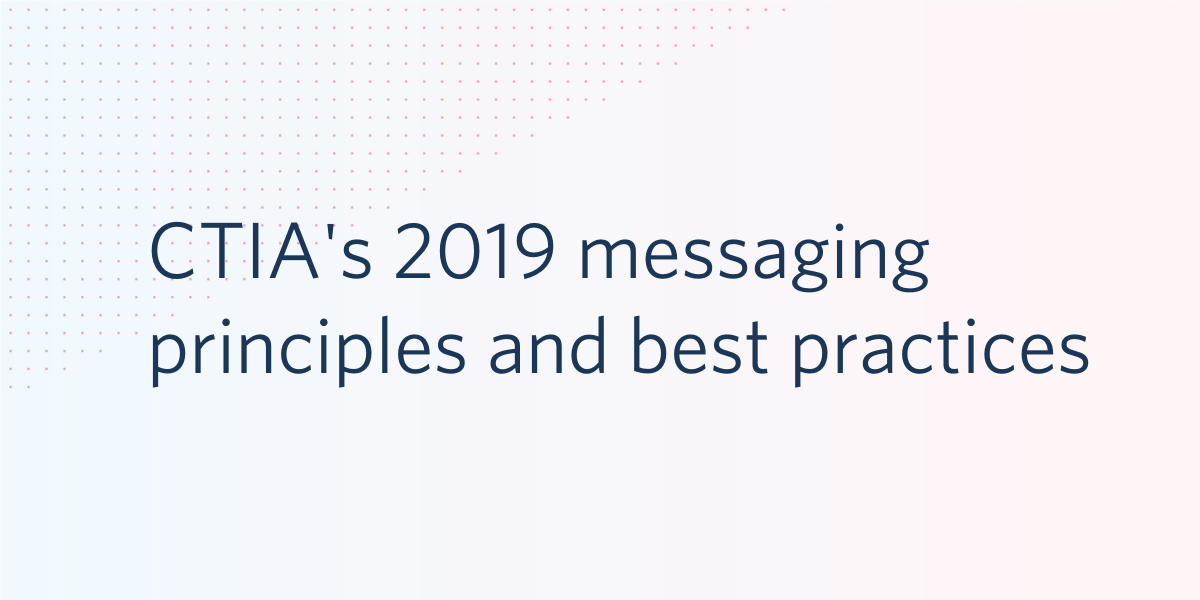CTIA's Updated 2019 Messaging Principles and Best Practices
Time to read:

The Cellular Telecommunications Industry Association (CTIA) is a trade association that represents the wireless communications industry in the US.
The CTIA puts out a messaging principles and best practice guide for businesses using SMS to communicate with their customers. Ultimately, their intent is to ensure messages that consumers receive are messages consumers WANT to receive. Businesses looking to use text messaging to communicate with consumers need to heed the CTIA’s guidelines to successfully use SMS to reach their end-users or target customers.
Their most recent Messaging Principles and Best Practices guide contains important updates to guidelines around Application-to-Person messaging. As members of the CTIA, Twilio is committed to creating a healthy messaging ecosystem that serves all participants. As such, we are educating our customers about recent changes in the CTIA best practices guide.
If you send A2P messages, please read and understand how the new guidelines affect you.
CTIA’s newest messaging principles and best practices
CTIA has just released their updated Messaging Principles and Best Practices guide (2019 CTIA Best Practices). This update replaces its 2017 Messaging Principles and Best Practices guide.
The latest update clarifies the difference between Consumer or Person-to-Person (P2P) and Non-Consumer or Application-to-Person (A2P) messaging and creates guidelines around A2P messaging.
Below is a brief highlight of these changes. For the full changes please refer directly to the CTIA guidelines [PDF].
How CTIA’s new guidelines may affect you
While some Twilio political messaging customers may have previously categorized their messaging services as P2P communications, under CTIA’s 2019 Best Practices these messages are now clearly categorized as A2P.
Channels currently available to provide A2P include Toll-Free SMS and Short Code numbers. In the future, we will also have A2P 10DLC dedicated to A2P messaging. This is important since A2P messaging recipients must give their express consent to receive A2P messages.
Occasionally, we may receive an escalation from a carrier partner regarding unwanted A2P messages sent to an end-user. In that event, we will contact the Twilio customer to request proof of consumer opt-in. The customer must then provide proof of express consent within 24 hours (generally, this will include a screenshot of the web form with correct opt-in language, and a record showing the time-stamp, name, and phone number of the consumer who opted in).
This could also be a printed form showing that the customer signed, in-person, with a clear indication that they were opting into receiving text messages. You can learn more about compliant messaging best practices in our whitepaper.
Under the updated guidelines, Twilio’s political messaging customers must now seek express consent from the individuals to whom they send messages by the mechanisms outlined above. If a consumer/recipient has not given consent to receive the messages, Twilio customers should anticipate that their A2P messages will be heavily filtered.
Related Posts
Related Resources
Twilio Docs
From APIs to SDKs to sample apps
API reference documentation, SDKs, helper libraries, quickstarts, and tutorials for your language and platform.
Resource Center
The latest ebooks, industry reports, and webinars
Learn from customer engagement experts to improve your own communication.
Ahoy
Twilio's developer community hub
Best practices, code samples, and inspiration to build communications and digital engagement experiences.

